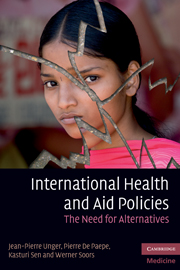Book contents
- Frontmatter
- Contents
- Preface
- Biographies
- Notices
- Acknowledgements
- List of abbreviations
- Reviews
- Introduction: Overview and purpose
- Section 1 Paradigms of international policies
- Section 2 The failure of the aid paradigm: poor disease control in developing countries
- Section 3 Impact of international health policies on access to health in middle-income countries: some experiences from Latin America
- 6 Costa Rica: achievements of a heterodox health policy
- 7 Colombia: in vivo test of health sector privatization in the developing world
- 8 Chile's neoliberal health reform: an assessment and a critique
- Section 4 Determinants and implications of new liberal health policies: the case of India, China and Lebanon
- Section 5 Principles for alternative, publicly oriented health care policies, planning, management and delivery
- Section 6 A public health, strategic toolkit to implement these alternatives
- Conclusions
- Glossary
- Index
- References
6 - Costa Rica: achievements of a heterodox health policy
Published online by Cambridge University Press: 06 December 2010
- Frontmatter
- Contents
- Preface
- Biographies
- Notices
- Acknowledgements
- List of abbreviations
- Reviews
- Introduction: Overview and purpose
- Section 1 Paradigms of international policies
- Section 2 The failure of the aid paradigm: poor disease control in developing countries
- Section 3 Impact of international health policies on access to health in middle-income countries: some experiences from Latin America
- 6 Costa Rica: achievements of a heterodox health policy
- 7 Colombia: in vivo test of health sector privatization in the developing world
- 8 Chile's neoliberal health reform: an assessment and a critique
- Section 4 Determinants and implications of new liberal health policies: the case of India, China and Lebanon
- Section 5 Principles for alternative, publicly oriented health care policies, planning, management and delivery
- Section 6 A public health, strategic toolkit to implement these alternatives
- Conclusions
- Glossary
- Index
- References
Summary
Adapted from: Unger JP, De Paepe P, Buitrón R, Soors W. Costa Rica: Achievements of a heterodox health policy. American Journal of Public Health 2008; 98(4): 636–643.
Introduction
Costa Rica is a MIC with a strong governmental emphasis on human development. For more than half a century, its health policies have applied the principles of equity and solidarity to strengthen access to care through public services and universal social health insurance.
Costa Rica's population measures of health service coverage, health service use, and health status are excellent, and in the Americas, life expectancy in Costa Rica is second only to that in Canada. Many of these outcomes can be linked to the performance of the public health care system.
However, the current emphasis of international aid organizations on privatization of health services threatens the accomplishments and universality of the Costa Rican health care system.
For several years, international development agencies, including the WB and the IMF, have promoted the role of for-profit health care facilities and programmes in the delivery of health care services in developing countries while narrowing the role of the not-for-profit sector in disease control (World Bank, 1993). Using as an example the experience of Costa Rica, we question the privatization of health care policy promoted by international aid agencies.
During a 2001 press conference, former WB president James D. Wolfensohn recognized Cuba for having done a ‘terrific job’ in the area of health (World Bank, 2001).
- Type
- Chapter
- Information
- International Health and Aid PoliciesThe Need for Alternatives, pp. 69 - 82Publisher: Cambridge University PressPrint publication year: 2010



